Looking in the mirror, I felt sad about my belly fat. It was a big reminder of my long fight. I was determined to find a way to lose it.
I found a 30-day diet plan that promised to help. It focused on eating right and managing calories. I was excited to try it and get the body I wanted.
The plan had lots of tasty meals and was easy to prepare. It got better each week, keeping me excited to keep going. With help from experts and my loved ones, I started a big change in my life.
Understanding Visceral Fat and Its Health Impacts
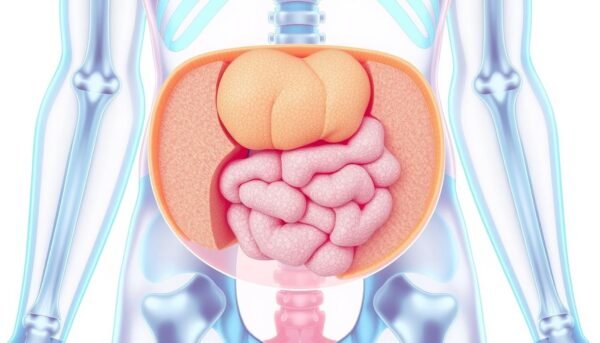
Visceral fat is deep fat around your organs. It’s different from the fat you can see under your skin. Knowing about visceral fat and its risks is key to a healthy body.
Link Between Belly Fat and Chronic Diseases
Too much visceral fat raises your risk of many diseases. It can triple your chance of getting dementia, Alzheimer’s, and some cancers. It also increases your risk of diabetes, high blood pressure, and heart disease.
How Visceral Fat Affects Your Body
Visceral fat is more active than other fat. It can mess with your hormones and how your body uses energy. This can lead to weight gain, low energy, and more.
Risk Factors of Excess Abdominal Fat
Many things can lead to too much visceral fat. These include a bad diet, not moving enough, stress, and genes. If you’re very overweight or have a big waist, you might have more visceral fat.
Keeping your body fat in check is important for your health. By knowing the risks and taking action, you can avoid chronic diseases and stay healthy.
| Key Statistics on Visceral Fat | Value |
|---|---|
| Percentage of body fat that is subcutaneous | 90% |
| Percentage of body fat that is visceral | 10% |
| Increased risk of heart disease for women with larger waists | 2 times |
| Increased risk of heart disease for every 2-inch gain in waist size for women | 10% |
| Increased risk of dementia and Alzheimer’s for those with more belly fat | 3 times |
| Increased risk of precancerous colon polyps for those with the most visceral fat | 3 times |
Key Principles of the 30-Day Weight Loss Journey
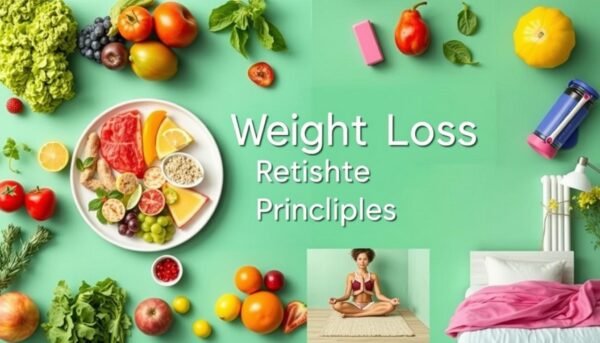
Starting a 30-day weight loss challenge means making big changes. It’s about eating right, exercising often, and feeling good overall. These steps help you lose weight in a healthy way.
- Embrace a Nutrient-Dense Diet: Eat lots of veggies, fruits, whole grains, and legumes. They’re full of vitamins and keep you full too.
- Prioritize Protein Intake: You need enough protein to keep your muscles strong. Eat lean meats, fish, and beans for this.
- Incorporate Healthy Fats: Nuts, seeds, avocados, and olive oil are good for you. They make you feel full and give you energy.
- Focus on Fiber-Rich Foods: Foods like oats, chickpeas, and brussels sprouts help with digestion. They also make you feel full.
- Embrace Probiotics and Fermented Foods: Yogurt, kefir, and sauerkraut are good for your gut. A healthy gut is key for losing weight.
- Maintain Adequate Hydration: Drinking water helps you feel full and removes toxins. It can also help you lose weight.
- Prioritize Sleep and Stress Management: Good sleep and stress control help your body work right. This is important for losing weight.
- Engage in Regular Physical Activity: Mix cardio and strength training to burn calories and build muscle. This boosts your metabolism.
Stick to these principles for a 30-day weight loss journey. It’s a path to lasting health and a better lifestyle.
Essential Foods That Help Lose Belly Fat
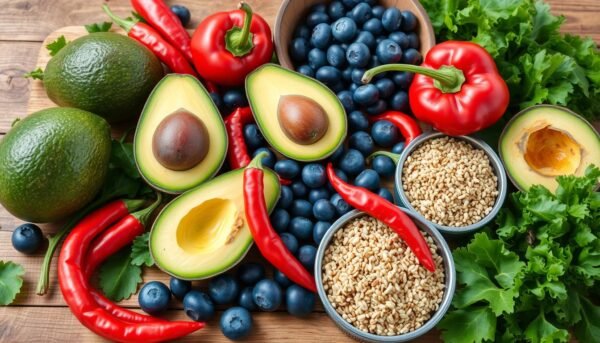
To get a flat belly, you need a smart diet plan. Some foods are great at burning fat, boosting metabolism, and more. Adding these foods to your diet can help you lose belly fat in 30 days.
Fiber-Rich Foods for Fat Burning
Eating more high-fiber foods is key to losing belly fat. Soluble fiber makes you feel full and helps digest food better. Good sources include:
- Berries
- Artichokes
- Lentils and beans
- Whole grains like oats and quinoa
- Leafy greens
Protein Sources for Weight Management
Protein-rich foods keep you full and help build muscle. They also keep your metabolism healthy. Good protein sources for losing belly fat are:
- Lean meats like chicken and turkey
- Fatty fish such as salmon and mackerel
- Greek yogurt and kefir
- Eggs
- Legumes like chickpeas and lentils
Metabolism-Boosting Ingredients
Some foods and drinks can speed up your metabolism. This helps burn more fat and slim down your waist. Try adding these to your diet:
- Green tea
- Spices like cayenne pepper and ginger
- Avocado
- Apple cider vinegar
- Nuts and seeds
For lasting belly fat loss, eat well and exercise often. Adding these foods to your 30-day plan will help you reach your weight loss goals. You’ll get a flatter, healthier belly.
Meal Planning Fundamentals for Weight Loss Success
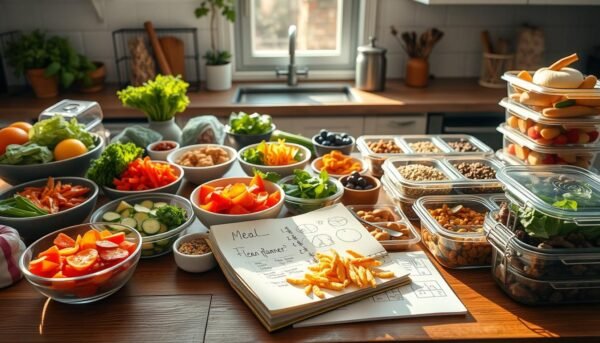
Meal planning is key for losing weight. It helps you avoid unhealthy choices. By planning meals, you can stick to a healthy diet.
Meal planning stops you from eating junk food. With a plan, you can make healthy meals. These meals help you reach your weight loss goals.
- Prepare meals in advance to have them ready when you need them.
- Use a grocery list to avoid impulse buying and stick to your healthy eating plan.
- Include no-cook meals, such as salads or wraps, for added convenience.
- Stock your pantry with versatile staples like canned beans, whole grains, and healthy fats.
- Consider joining a Community Supported Agriculture (CSA) program or visiting a local farmers market to access fresh, seasonal produce.
Planning meals helps you eat well and lose weight. It’s all about being consistent and committed. This way, you can keep a healthy lifestyle.
| Meal Planning Tips for Weight Loss | Benefits |
|---|---|
| Prepare meals in advance | Ensures you have healthy options ready to go, reducing the likelihood of impulsive, unhealthy choices |
| Use a grocery list | Helps you stick to your healthy eating plan and avoid impulse buys |
| Include no-cook meals | Provides convenient, time-saving options that support your weight loss goals |
| Stock your pantry with staples | Allows you to easily create nutritious meals and snacks on the go |
| Utilize local, seasonal produce | Ensures you have access to fresh, flavorful ingredients that can be incorporated into your weight loss meals |
Week-by-Week Meal Structure to Lose Belly Fat
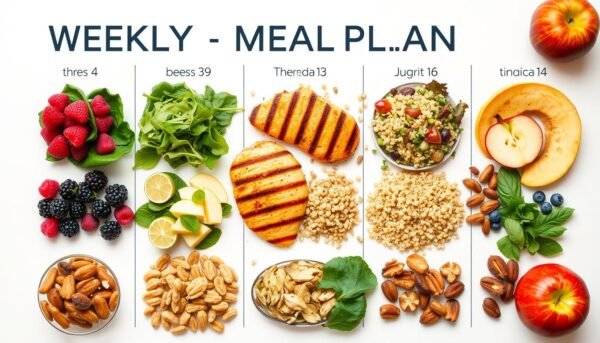
Starting a weight loss journey can feel tough. But with a good weekly meal plan, losing belly fat is easier. We’ll see how meals change over four weeks. This ensures a steady diet progression and the best meal structure for great results.
Week One Meal Guidelines
In the first week, we start strong. Meals will focus on whole, nutrient-rich foods. These are high in fiber and protein. You’ll eat lean meats, veggies, fruits, and whole grains. The goal is to eat a bit less to start losing weight.
- Breakfast: Oatmeal with berries and a hard-boiled egg
- Lunch: Grilled chicken salad with mixed greens, cherry tomatoes, and avocado
- Dinner: Baked salmon with roasted sweet potatoes and steamed broccoli
- Snacks: Greek yogurt with sliced cucumbers, apple slices with almond butter
Week Two Diet Progression
As you get used to the weekly meal plan, we add more variety. This week, you’ll try different proteins, healthy fats, and carbs. This keeps meals fun and boosts your metabolism.
- Breakfast: Spinach and feta egg white omelet with whole-grain toast
- Lunch: Grilled chicken and quinoa bowl with roasted vegetables
- Dinner: Baked cod with sautéed kale and brown rice
- Snacks: Celery sticks with hummus, mixed nuts, and a small banana
Weeks Three and Four Optimization
In the last two weeks, we make your meal structure even better. We add more probiotics, metabolism boosters, and adjust portion sizes. This helps you lose weight in a healthy way.
Remember, staying consistent is crucial. By sticking to this weekly meal plan and making small changes, you’ll see great results. Keep going, and you’ll be amazed at how your body changes!
Smart Portion Control and Calorie Management
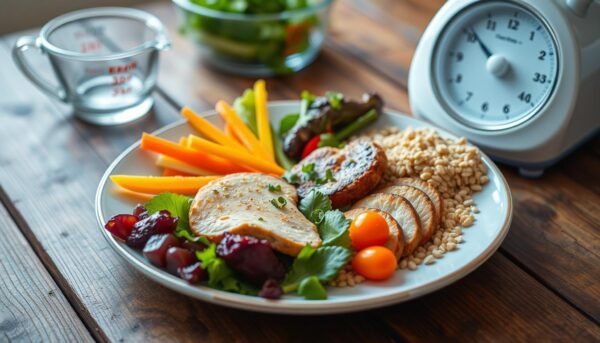
For lasting weight loss, balancing portion control and calorie management is key. This 30-day plan will teach you these skills for success.
A 1,500-calorie diet helps many lose weight. Knowing your total daily energy expenditure (TDEE) is important. The Mifflin-St. Jeor equation helps figure out your daily calorie needs.
Slow weight loss of 1–2 pounds a week is best. You’ll need to eat 500 calories less each day. Foods high in fiber and protein help with fat loss and keep you full.
- Eat non-starchy veggies, fruits, poultry, fish, lean meats, whole grains, and healthy fats on your 1,500-calorie diet.
- Stay away from processed foods, added sugars, fast food, refined carbs, fried foods, and sugary drinks.
Knowing your portion sizes is vital for meeting calorie goals. Look at Nutrition Facts labels for serving sizes. But, your needs may vary. Use a portion size calculator and the plate method to control your portions.
Measuring food on a scale helps understand portion sizes, especially at first. You can adjust portion sizes as long as you meet nutritional needs. Mindful eating is also a great way to control portions and stay within calorie limits.
Incorporating Gut-Healthy Foods and Probiotics
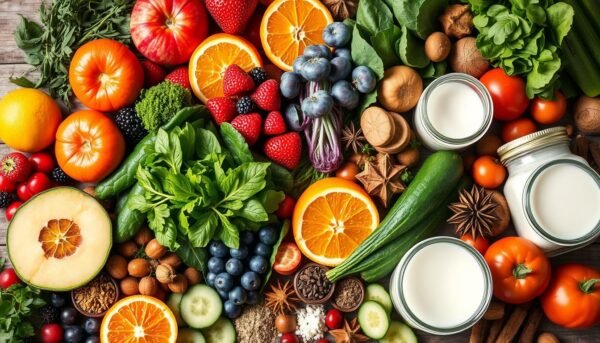
To support your weight loss journey, focus on gut health. Your gut microbiome affects metabolism, digestion, and fat storage. Adding gut-healthy foods and probiotics to your 30-day plan boosts your body’s fat loss.
Fermented Foods Benefits
Foods like kimchi, kombucha, and yogurt are full of good bacteria. These microbes help balance your gut, improve nutrient absorption, and burn fat. Eating fermented foods is a tasty way to support your weight loss.
Prebiotic and Probiotic Combinations
Combining prebiotic foods like artichokes, asparagus, and whole grains with probiotics is beneficial. Prebiotics feed the probiotics, helping them grow in your gut. This combo can improve your gut, metabolism, and weight loss.
By prioritizing gut health in your 30-day plan, you’re on the path to lasting weight loss. Eat a variety of gut-healthy foods and probiotics to help you reach your health goals.
Lifestyle Changes to Support Your Diet Plan
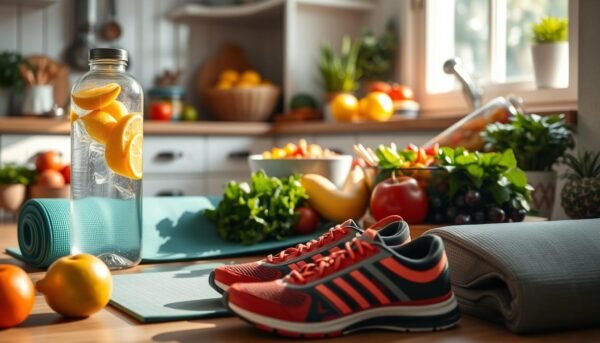
Getting to a healthy weight is more than just dieting. To help you lose weight for 30 days, making lifestyle changes is key. These changes will help you succeed in the long run. Let’s look at some important areas to focus on:
Get Enough Sleep
Sleeping well is vital for controlling hunger and metabolism hormones. Try to sleep 7-8 hours each night. This helps with hunger, energy, and burning fat.
Manage Stress
Too much stress can make you store more belly fat. Try yoga, meditation, or deep breathing to lower stress.
Limit Alcohol Intake
Drinking too much can hurt your weight loss by adding empty calories. Try to drink less or choose low-calorie drinks instead.
Increase Physical Activity
Exercise is key for losing weight. Mix aerobic exercise (like walking, swimming, or cycling) with strength training. This burns fat, builds muscle, and keeps you healthy.
| Lifestyle Factor | Benefits for Weight Loss |
|---|---|
| Adequate Sleep | Regulates hunger hormones, supports metabolism |
| Stress Management | Reduces cortisol levels, prevents belly fat accumulation |
| Moderate Alcohol Intake | Avoids empty calories, preserves metabolic function |
| Regular Exercise | Boosts fat-burning, builds muscle, supports overall health |
By making these lifestyle changes, you’ll support your 30-day weight loss plan. Remember, losing weight is a journey. These changes will help you keep healthy habits long after your 30-day goal.
Meal Prep Strategies for Sustainable Results
Meal prepping is a big help for losing weight and staying healthy. It lets me have healthy meals ready all week. Using slow cookers and batch cooking saves time and makes meal prep easier.
The 30-day plan gives me meal prep tips each week. In the first week, I’ll make overnight oats and grain bowls for quick meals. Later, I’ll freeze meals like stir-fries and soups for easy dinners.
Having the right ingredients in my kitchen helps me make healthy meals. This way, I can avoid buying unhealthy food and stick to my diet. It helps me lose belly fat in a sustainable way.
This post may contain affiliate links which means I may receive a commission for purchases made through links. I will only recommend products that I have personally used! Learn more on my Private Policy page.